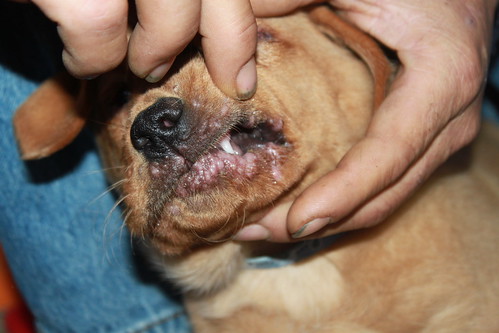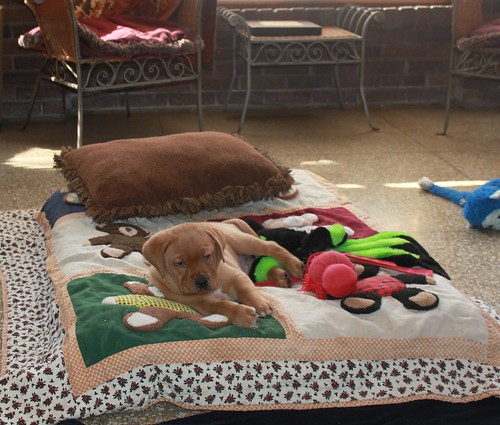Puppy strangles
I want to alert you to a condition that may onset in puppies between the ages of two and four months about a disease called puppy strangles, otherwise known as juvenile cellulitis. I am not a vet nor do I pretend to be. While we don’t see cases of it every day, it is nonetheless not rare. They say if you breed long enough you will see little bit of everything.
Because it is often misdiagnosed and because it has potentially fatal consequences, you may want to bring this information to your veterinarian’s attention should your puppy present any of the typical symptoms:
Symptoms
The condition is variously referred to as juvenile cellulitis, cellular dermatitis, juvenile pyoderma, or puppy strangles. It has a number of symptoms, any and all of which may occur, and in varying order. Among them are the appearance of small, pimple-like bumps around the eyes, the muzzle, the abdomen, and other parts of the body. These mock the appearance of bacterial rashes, and may break open and weep a yellowish liquid and then crust over.
While many minor conditions may cause a belly rash on pups, the presence of pustules inside the ears is a real warning sign. They begin quite small and can eventually cover the inner surface of the ear with weeping pustules. The entire ear leather may also swell significantly.
Other signs include discharge from, swelling of, and hair loss around the eyes, swelling of the muzzle with attendant hair loss, and swollen lymph nodes in the throat and in the backs of the thighs.
Be particularly concerned if rash-like areas are accompanied by swollen glands.
This is primarily an immune system disorder, and although it may look like a bacterial infection, it will not respond to antibiotic treatment alone. Other similar-appearing skin outbreaks, such as puppy impetigo, result from minor bacterial infections, and will ultimately disappear whether treated or not. This is not the case with cellulitis, although some veterinary dermatologists believe there may be a rod-like bacteria associated with the condition, similar to the one that causes cat scratch disease.
Essentially what is going on with the pups is that their immune systems are activated by normal development and environmental exposures but then overreact and start identifying the body’s own tissues as agents to attack. The lymph glands swell since it is the lymphatic system that supplies and distributes the body’s immune responses, and the pustules
are actually filled with non-infected, sterile lymphatic fluid. You might think of the pup as having temporarily become allergic to himself.
The condition is evidently not an uncommon one and can occur in all breeds of dogs. It cannot be transmitted by contact from one littermate to another, or to anything or anyone else; and it can occur in one, a few, or all of the pups in a litter. The cause is not completely understood, but it does not seem to be a genetic problem.
It generally onsets in pups between the ages of two and four months, takes two to eight weeks to run its course, and if properly treated, leaves the pup with a completely healthy and functional immune system and no effect on future health or lifespan. Because the immune system is running haywire, so to speak, treatment consists of suppressing its action with corticosteroids, usually prednisone, with associated backup antibiotics in case of exposure to bacterial infection while the immune system is suppressed.
Depending on the severity of the condition and the pup’s response to treatment, the course of medication will run two to eight weeks. It is important to monitor the pup carefully once treatment has stopped. If the condition recurs, medication must be reinstituted for a longer period.
Eventually the immune system will sort itself out.
If the condition goes unidentified and untreated for some time, there may be rather extensive facial hair loss, which may result in some permanent adult scarring, but this is not the usual case.
The other grave danger to the pup comes from the swelling of the lymph glands in the throat, which may actually enlarge to the point where they interfere with the pup’s swallowing and breathing, thus the name puppy strangles.
While on steroid therapy you may notice an increased appetite, rather alarming weight gain, and a tendency to pant and to appear overheated and uncomfortable.
These are all unfortunate but unavoidable side effects which must be endured if they occur; they will resolve once the steroids are no longer needed.
Another important situation to be aware of is that while the pup’s immune system is being suppressed by the steroids, he will be unable to defend himself against any viral or parasitic disease that he encounters. The antibiotics will usually take care of any bacterial problems, but the pup is especially vulnerable to parvovirus and demodectic mange at this time, and you must exercise extreme care not to expose him to possible contaminated environments nor let him get overtired or overstressed with activities or concentrated training.
This does not mean to put him into a plastic bubble, but use good common sense, and for management of parvovirus make sure you have a spray bottle of a 1:30 chlorine bleach to water
mixture on hand at all times to decontaminate all new people and objects in the pup’s environment. It would also be useful to spray the pads of the pup’s feet with the bleach mixture anytime after he ventures into a public or semi-public area.
Causes & Risks
The cause of juvenile cellulitis is unknown, but is thought to be an immune system abnormality. There is some evidence that the condition can be hereditary. If left untreated, some puppies can die from this condition. Scarring and permanent hair loss can occur. Another issue is future breeding of the dam and this is difficult because there is no available information on genetics. However we do know that any dam needs a strong immune system to pass along to future generations. Consultation with your veterinarian before any future breedings are planned would be in order. A breeder who had such a pup in a litter should fully disclose the illness to those who purchase any other pups from that litter. It would be in the best interest of all pups to be carefully reared with full knowledge that one or more pups had been ill. They can make wonderful pets and have a normal lifespan but it would be poor ethics to omit disclosure. At the very least, discussion with your veterinarian is advised as to their management.
Treatment
The current treatment recommended consists of prednisone and an antibiotic. Suitable antibiotics are Clavamox, Cephalexin or Clindamycin. For a pup in the 20-pound range, This is how my vet treated our puppy strangles puppy. Start by giving 15 mg. of prednisone twice daily for three days, then 10 mg twice daily for three days, then 10 mg once daily for three days, then 5 mg once daily for three days. Give 250 mg. of Cephalexin or 6.25 mg/lb. of Clavamox twice daily and 500 mg glucosamine complex throughout the course of prednisone. After these 12 days, discontinue the prednisone and antibiotics and see if symptoms recur. If they do, steroid and antibiotic therapy must be reinstituted. Continue the glucosamine for at least two weeks after final prednisone use.
The most important thing is to identify the symptoms early. I cant say this enough, early prednisone is the cure.
Affected puppies are usually between one and four months of age. with symptoms that are often quite shocking in appearance. They include a swollen face, ears, muzzle, and spectacularly enlarged lymph nodes. The symptoms are consistent with other diseases and must be differentiated from a severe bacterial or fungal infection and mange (Demodex or Sarcoptes mites under the skin). Puppy strangles can be quite painful, unlike the other diseases just mentioned.
While it may appear that these dogs have some sort of infection, true puppy strangles is an auto-immune disease, meaning that the puppy’s own immune system has, for some reason, gone a “little haywire”. Therefore, treatment involves the use of prednisone, as an immunosuppressant, for cure. Within one to two weeks of treatment, affected puppies respond very favorably. The disease is curable and does not recur.
The cause of the disease is still unknown but some evidence shows that it may be hereditary. Others say that it is due to an abnormality or dysfunction in the immune system of the said puppies. Taking good care of these young pets would require you to administer the right treatments and healthcare in order to protect them from the adverse effects of this skin disease.
This is little Phoenix and our battle with Puppy strangles here he is at 8 weeks
The Day before his symptoms started
Day 5 after symptoms started
After Predisone and treatment started
Phoenix At 2 years old
Phoenix at 19 months
My Blog on Phoenix
On The 15th I gave the pups their 6 week vaccinations . I noticed one of the males looked like he had Chickenpox under his eye lid and around his mouth Took him to the vet they didn’t seem too concerned they gave him Bendryl and put him on Clavamox. The next day he looked worse and now he developed a limp left leg he would put some weight on it but not much. He had been on the Clavomox since Wednesday. On Friday I didn’t see much improvement but I had to work out of town for the weekend. My Husband was staying home with him. On Sunday morning my husband called me with concerns and said he didn’t think he was doing well. On Sunday afternoon he called me said he was panting and wouldn’t come out of the crate that I have in the puppy house (it doesn’t have a door on it just helps with crate training). My husband doesn’t usually get over excited I could hear it in his voice something was seriously wrong. He said his eyes were swollen shut and he was lethargic ( no vomiting or diarrhea ). He took him immediately to the emergency vet.
I headed home from Wichita scared to death of course. Emergency Vet was very aggressive ( didn’t take him to my regular vet) Thank God, ran every test under the sun. Gave him a new antibiotic, steroids ect. He was not dehydrated. WBC was 18,000 all the rest of his blood work was normal. Lymph nodes terribly swollen (looked like a chipmunk) Fever of 104.5. he had also developed a strange limp left leg. She offered to keep him overnight but said he’d probably be better off at home with me where I could watch him closely. Sunday night we were up every hr checking his temp. ect..By Monday Morning swelling was completely gone in both eyes, fever gone. She said whatever it was was Bacterial because the Clavomex wasn’t touching it. So we took him off of the Clavomox and put him on Clindamyacin. At Home treatment suggested by my vet. Started by giving 15 mg. of prednisone twice daily for three days, then 10 mg twice daily for three days, then 10 mg once daily for three days, then 5 mg once daily for three days. Give 250 mg. of Cephalexin or 6.25 mg/lb. of Clavamox twice daily and 500 mg glucosamine complex throughout the course of prednisone. After these 12 days, discontinue the prednisone and antibiotics and see if symptoms recur. If they do steroid and antibiotic therapy must be reinstituted. Continue the glucosamine for at least two weeks after final prednisone use.
Yesterday was still a little rough though still limping just sleeping a lot but still eating and drinking but a 100% better than Sunday. Scheduled x-rays for 9am this morning (Tuesday). He slept through he night last night I peeked in him every 2 hrs. I got up at 5 am and WOW he came running to me and I mean running. Only a slight limp ( the past few days he would barely put weight on his left leg). His tail is wagging, lymph nodes almost completely back to normal they were the size of golf balls now about the size of a peanut. Eyes completely normal. He ate all of his breakfast, stools are normal.













